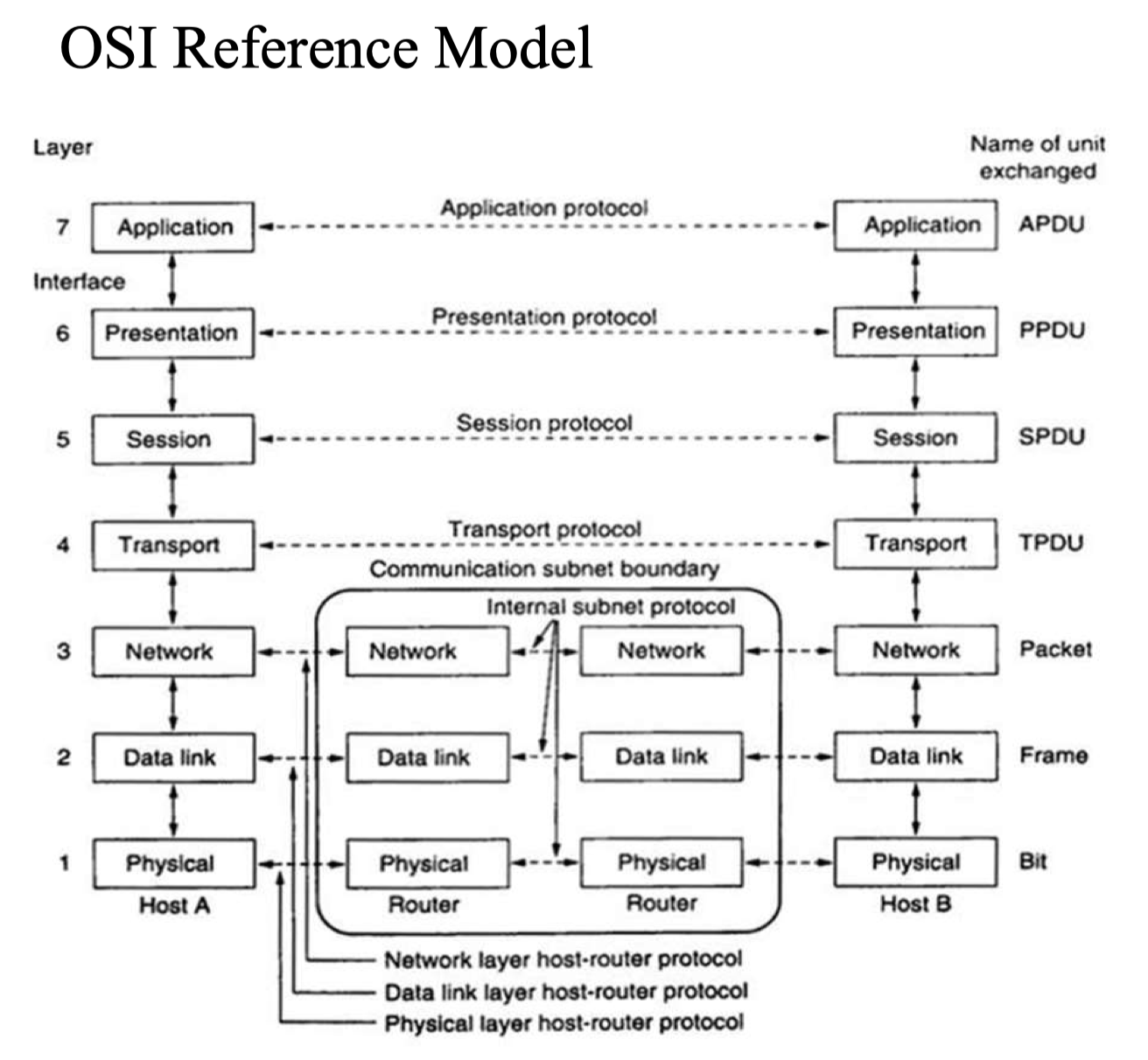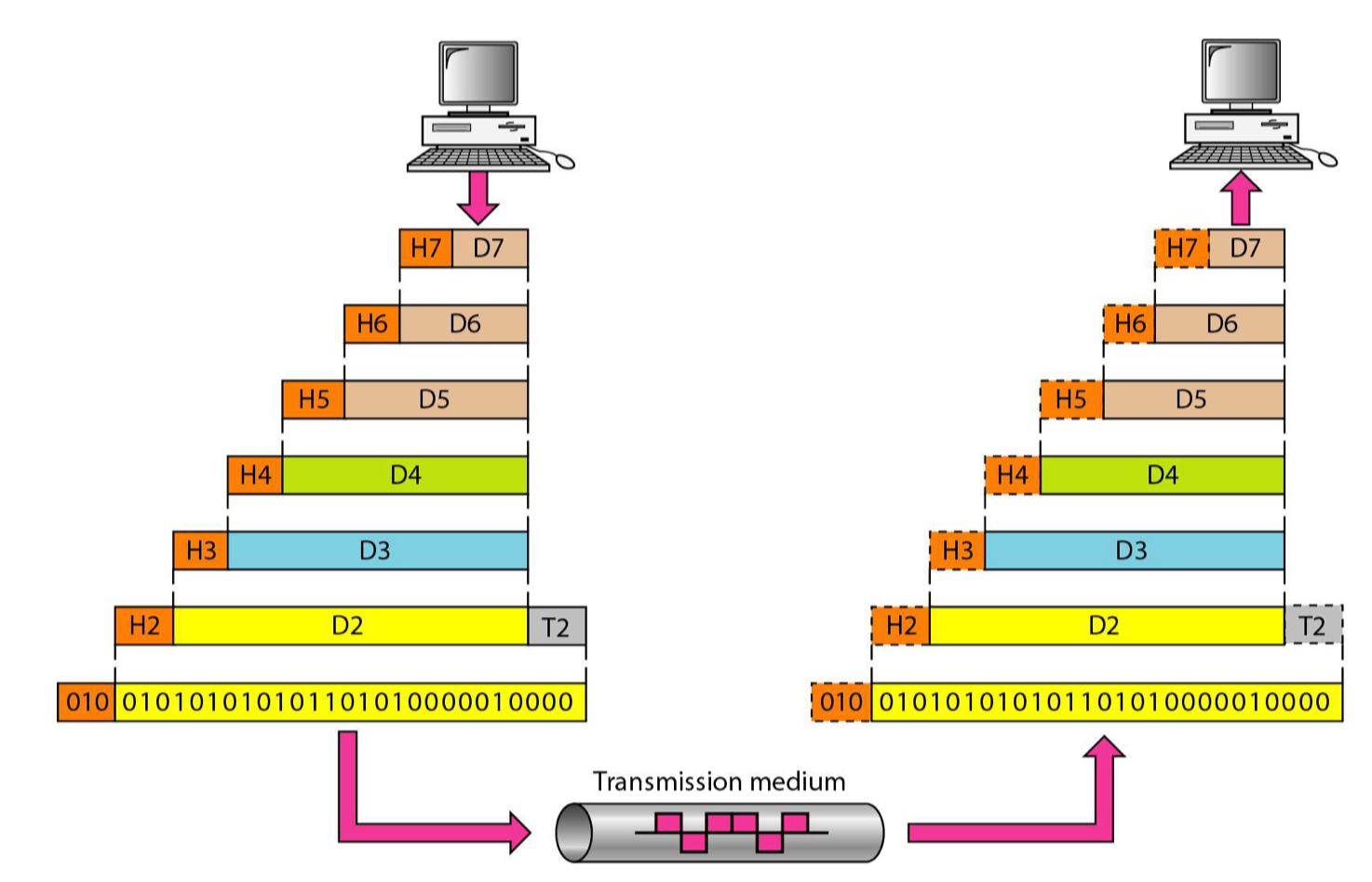建于:2024-02-20 11:32:00 Tuesday 9333字 32分
NOTE, Network, Lec1, and UIC
CC BY 4.0(除特别声明或转载)
Basic-Concepts
- The term telecommunication means communication at a distance.
- The word data refers to information presented in whatever form is agreed upon by the parties creating and using the data.
- Data communications are the exchange of data between two devices via some form of transmission medium such as a wire cable.
Data Communication Components

- Five components of data communication
- Sender
- Medium
- Receiver
- Protocol
- Message
[!abstract]+ Network Protocol
- Communication node is machine
- All communication activity in the Internet is controlled by protocols
- Protocols define formats, order of sending and receiving of messages, and the actions that the reception initiates
Data Flow
- Simplex 单向 单向同时只有一路信号
- TV
- Half-duplex 半双工 双向同时只有一路信号
- Interphone
- Full-duplex 全双向 双向同时有两路信号
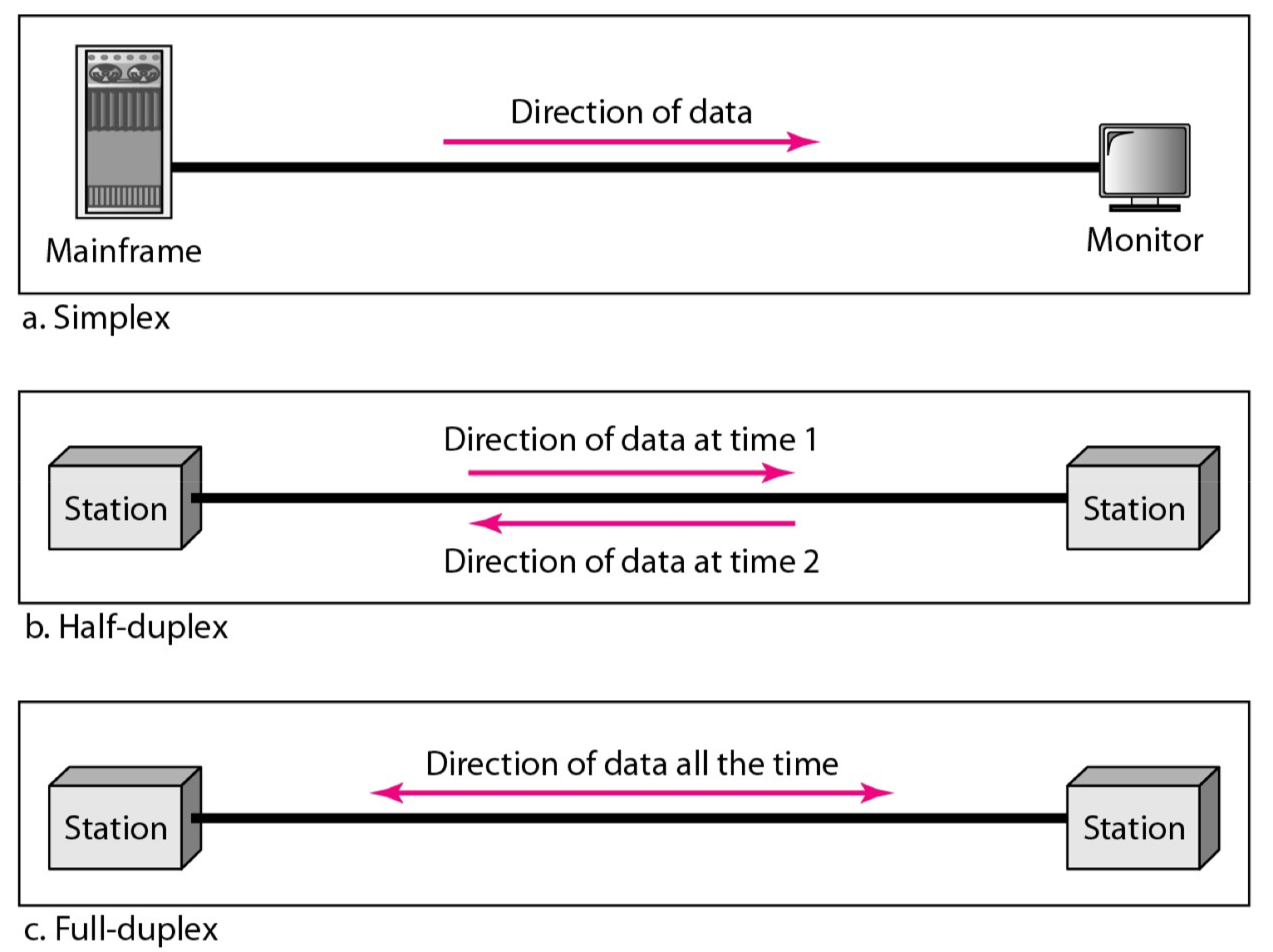
Fundamentals of Data and Signals
Analog Versus Digital
- Analog signals are continuous electrical signals that vary in time. 模拟信号
- Digital signals are non-continuous. 数字信号
- They consist of pulses or digits with discrete levels or values.
- The value of each pulse is constant.
- Digital signals usually have two amplitude levels such as 1 or 0, HIGH or LOW.
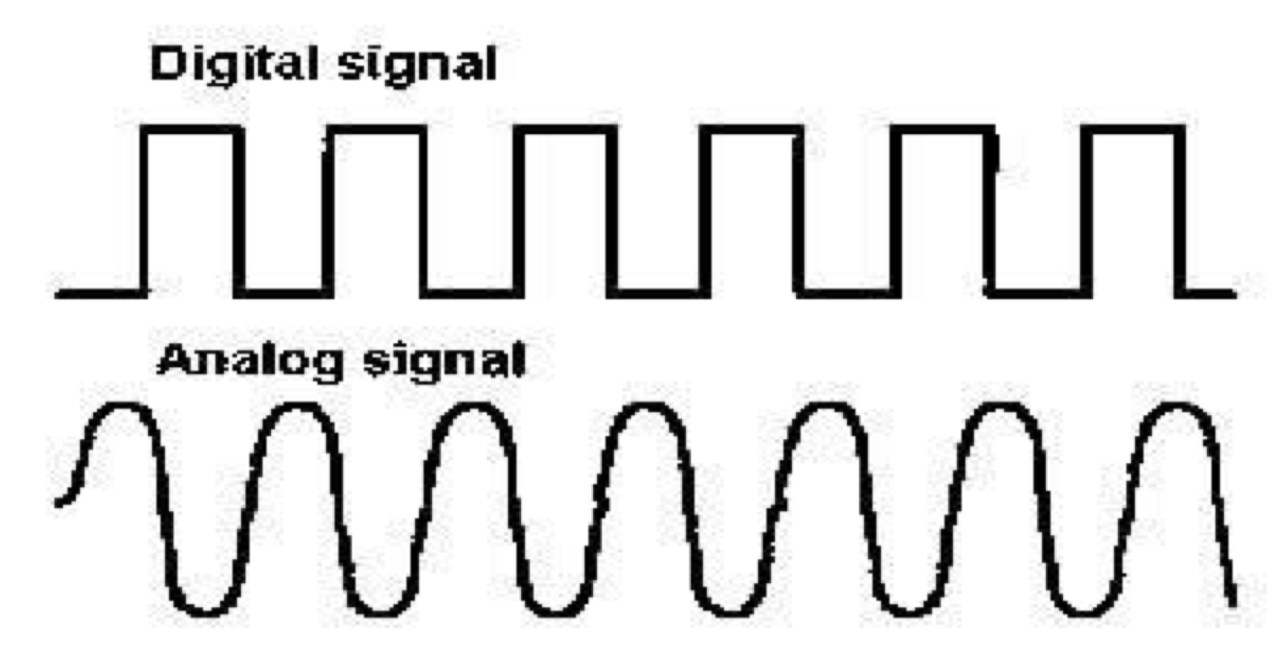
Advantages of Digital Signals
- Less sensitive to the interferences (e.g., noise, magnetic field) 对扰动不敏感
- Easier for further processing (e.g., error correction, storage, etc.) 方便后续处理

Digital Encoding Schemes
Transmitting digital data with digital signals 数字信号->数字信号
- Non-return to zero digital encoding scheme 不归零数字编码方案
- ‘1’ bit is sent as a high value and ‘0’ bit is sent as a low value.
- The receiver may lose synchronization because the data may contain long runs of consecutive bits with the same value [no changes in voltage].
- Manchester digital encoding scheme 曼彻斯特数字编码方案
- The digital data is represented as: ‘0’ bit by a voltage from low to high; ‘1’ bit by a voltage from high to low.
- Manchester encoding is a synchronous clock encoding technique to encode the clock and data of a synchronous bit stream.
- 数字数据表示为:“0”位由电压由低到高; “1”位由电压由高到低。 曼切斯特编码是一种同步时钟编码技术,用于对同步比特流的时钟和数据进行编码。

Efficiency : 50%
- 4B/5B digital encoding scheme
- It produces a signal for a group of bits each time, rather than outputting a signal for each individual bit.
- Each time, a 4-bit input data (16 different bit patterns) is encoded as a 5-bit data (32 different bit patterns).
- By carefully choosing the 5-bit patterns which always contain two ‘1’s even if the input data is all ‘0’s, the clock synchronizations can be achieved.
- 它每次为一组位产生信号,而不是为每个单独的位输出信号。 每次,4位输入数据(16种不同的位模式)被编码为5位数据(32种不同的位模式)。 通过仔细选择总是包含两个’1’的5位模式,即使输入数据都是’0’,也可以实现时钟同步。
Efficiency : 80%
Transmitting digital data with analog signals 数字信号->模拟信号
- AM - Amplitude Modulation 调幅
- Carrier载波
- On/Off 机械的表达
- Presence of the carrier:1
- Absence (or no carrier) :0

- FM - Frequency Modulation 调频
- A 0 is represented by the original carrier frequency
- A 1 by a much higher frequency (the cycles are spaced closer together).
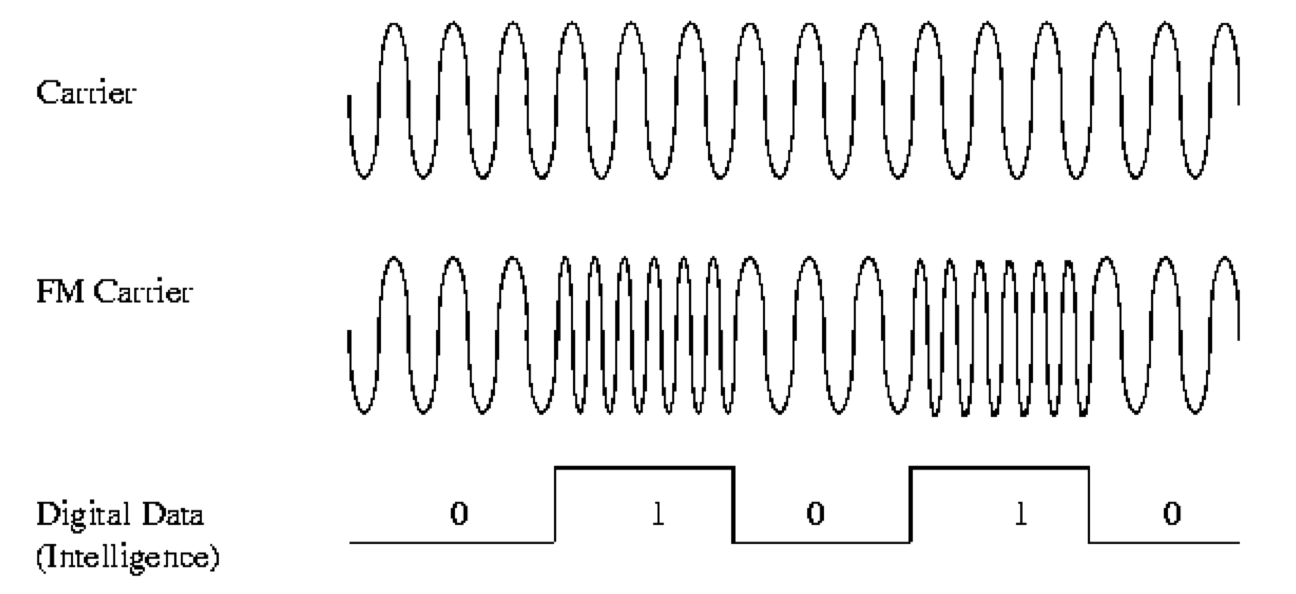
- Frequency Modulation modifies the frequency of the carrier to represent the 1s or 0s. 操纵频率表示0/1
- PM - Phase Modulation 调相
- 载波相位在每次出现1位时切换,但在0位时不受影响。
- 这些位被定时以符合特定的载波周期数。

Convert Analog Signal to Digital Signal 模拟信号->数字信号
- Pulse Coding Modulation 脉冲编码调制
- Sampling 采样
- 是模拟-数字转换过程中的第一步,涉及按照特定的时间间隔(采样率)测量连续模拟信号的瞬时值。采样率必须至少是信号中最高频率的两倍,这是根据奈奎斯特定理来决定的,以确保信号可以被无失真地重建。
- Quantitation 量化
- 采样后的步骤是量化,这个过程涉及将每个采样点的模拟值映射到最接近的数字级别。量化步骤确定了信号的数字表示可以取的不同值的数量。在图像中,量化被表示为一系列的水平线,每一条线对应一个量化级别。每个采样值被”量化”到最接近的这些水平线上。在量化过程中,采样值是用比特数表示的,而这个比特数(8位到24位)决定了可能的量化级别的数量,也就是量化精度。
- Sampling 采样

- PCM samples the signal from 8 to 192 thousand times per second; each sample is represented by 8 to 24 bits.
Capacity of Communication Channel
- $Nyquist’s\ Theorem$
- Assumption: noise free in the channel
- Formula: \(B=2F(log_2M)=\frac{2log_2M}{T}=\frac{2}{T}(When\ M=2)\)
- B = Bit Rate (bit/sec)
- F = Channel Bandwidth in Hertz
- M = Number of levels in a signal (two for binary)
- $Shannon’s Theorem$
- In reality, the signal may be corrupted by electrical noise.
- Formula: \(B = F[log_2(1+\frac{S}{N})]\)
- B = Actual Bit Rate (bit/sec)
- F = Channel Bandwidth in Hertz
- S = Signal Power in watts
- N = Noise Power in watts
- $Signal-to-Noise\ Radio$ \(SNR_{dB}= 10\ log_{10}{\frac{S}{N}}\) \(SNR=10^{\frac{SNR_{db}}{10}}\)
Computer Networks
- A network is a set of devices(often referred to as nodes) connected by communication links.
- A node can be a computer, printer, or any other device capable of sending and/or receiving data generated by other nodes on the network.
Network Hardware
- The computer networks can classified as the following 4 categories
- Local loop
- LANs
- MANs
- WANs
Local Loop 本地回路
- It refers to the “last mile” of analog phone line that goes from the Exchange Centre to your house. 指从交换中心到您家的 “最后一英里 “模拟电话线。
- Voice lines 话频线路
- Modem (56 kbps) 调制解调器
- ISDN (Integrated Services Digital Network): 2 x 64 kbps digital lines
- ADSL (Asymmetrical Digital Subscriber Line): up to 8 Mbps
- Cable Modems (up to 30 Mbps) 电缆调制解调器
- Network cable
Local Area Networks (LANs) 局域网
- LANs are privately-owned networks within a single building or campus of up to a few kilometers in size.
- LANs run at speeds of 10Mbps to 10Gbps, have low delay, and make very few errors.
- The topologies *拓扑 *of LANs are various: Bus, Ring, Star, etc.
MANs (Metropolitan Area Network) 城域网
- MANs are networks that connect LANs together within a city.
- Example: Cable television network
WANs (Wide Area Networks) 广域网
- WANs connect LANs together between cities.
- A WAN spans a large geographical area, often a country or continent.
Internetworks 互联网
- Many networks exists in the world with different hardware and software;
- To communicate, it is better to connect different networks together.
- A collection of interconnected networks is called an internetwork or internet (which is used in a generic sense, in contrast to the worldwide Internet).
Network Software
Protocol Hierarchies
Networks are recognized as a stack of layers or levels, each one built upon the one below it.
- Each layer offers certain services to the higher layers, shielding those layers from the details of how the offered services are implemented.
- Between each pair of adjacent layers is an interface. The interface defines which primitives operations and services the lower layer makes available to the upper one.每一对相邻层之间都有一个接口。接口定义了下层向上层提供哪些基本操作和服务。
Why Layering?
Management of complex systems:
- Modularization simplifies
- Design
- Maintenance
- Updating of a system
- Explicit structure allows
- Identification of the individual parts
- Relations among them
- Clear structure: layering
- Layered reference model
- Goal: different implementation of one layer fit with all implementations of other layers
Design Issues for the Layers
- Addressing: Every layer needs a mechanism for identifying senders and receivers.
- Rules of data transfer: simplex or duplex, no. of channels
- Error control: Both sender and receiver must agree on some sort of error-detecting and error-correcting codes.
- Sequence: The protocol must provide solution for receiver to reassemble the messages properly.
- Flow control: The protocol should provide a mechanism for sender and receiver to regulate the transmission rate.
- Routing: A mechanism must be provided to choose a route when there are multiple paths between source and destination.
Connection-Oriented and Connectionless Services
Connection-oriented Services
- To establish a connection, the sender, receiver and the subnet conduct a negotiation about parameters to be used, such as maximum message size, quality of service required, etc.
- The Quality of Service can be characterized in terms of Data Loss Rate, Delay Jitter, Data Rate, etc.
- Application Example: File transfer
Connectionless Service
- Each message carries the full destination address, and each one is routed through the system independent of all the others.
- No negotiation is needed between sender and receiver.
Service Primitives 原始服务
A service is formally specified by a set of primitives (operations) available to a user process to access the service. These primitives tell the service to perform some action or report on an action taken by a peer entity.
| Primitives | Meaning |
|---|---|
| LISTEN | Block waiting for an incoming connection |
| CONNECT | Establish a connection with a waiting peer |
| RECEIVE | Block waiting for an incoming message |
| SEND | Send a message to the peer |
| DISCONNECT | Terminate a connection |
Network Topologies and Categories
- Network Topology refers to the layout of a network.
- Different configurations of network cable, computers and devices form different topologies.

Bus Topology
- Bus topology: All devices are connected to a common backbone.
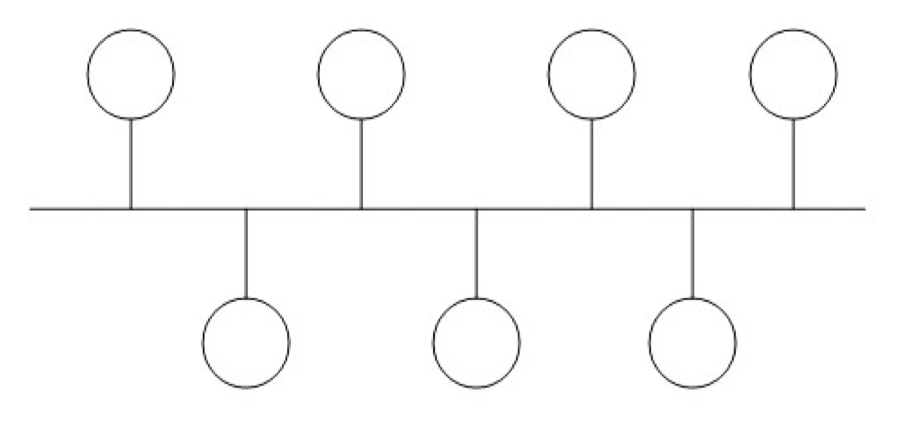
- Advantages
- Easy to connect a computer or peripheral to a linear bus. 方便连接
- Requires less cable length than a star topology. 耗材少
- Disadvantages
- Entire network shuts down if there is a break in the main cable. 不可靠
- Terminators are required at both ends of the backbone cable.
- Difficult to identify the problem if the entire network shuts down. o Not meant to be used as a stand-alone solution in a large building.
Ring Topology
- Ring topology
- In a ring network, every device has exactly two neighbors for communication purposes 管理复杂
- All messages travel through a ring in the same direction (either “clockwise” or “counterclockwise”)
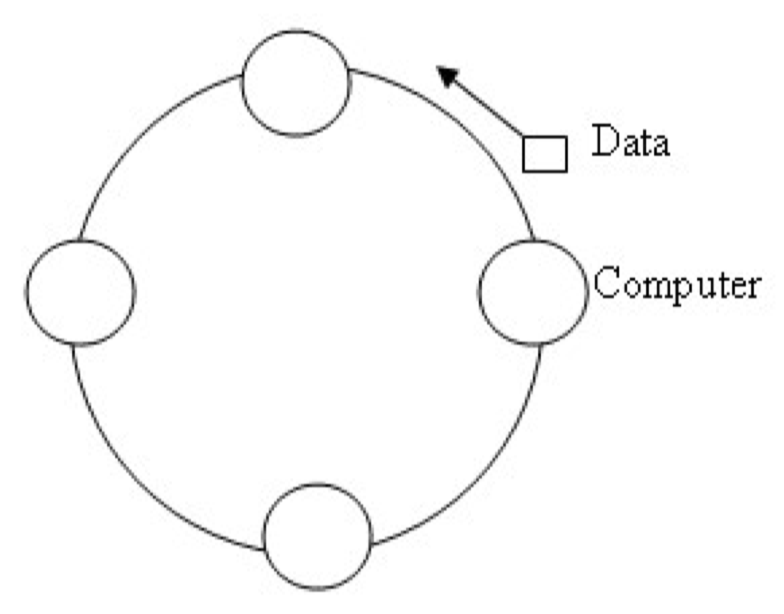
Star Topology
- Star topology
- A star topology is designed with each node (file server, workstations, and peripherals) connected directly to a central network hub or concentrator.
- Data on a star network passes through the hub or concentrator before continuing to its destination.
- The hub or concentrator manages and controls all functions of the network.
- It also acts as a repeater for the data flow.
- Advantages Current-connections
- Easy to install and wire.
- No disruptions to the network then connecting or removing devices.
- Easy to detect faults and to remove parts.
- Disadvantages
- Requires more cable length than a linear topology.
- If the hub or concentrator fails, nodes attached are disabled.
- More expensive than linear bus topologies because of the cost of the concentrators.

Tree Topology
- A tree topology combines characteristics of star and linear bus topologies.
- Tree topologies allow for the expansion of an existing network.
- For example, enabling schools to configure a network for labs.
- Advantages
- Point-to-point wiring for individual segments.
- Supported by several hardware and software venders.
- Disadvantages
- Overall length of each segment is limited by the type of cabling used.
- If the backbone line breaks, the entire segment goes down.
- More difficult to configure and wire than other topologies.

Mesh Topology
- A Mesh topology consists of a network where every device on the network is physically connected to every other device on the network.
- Advantages
- It provides a great deal of performance and reliability.
- Disadvantages
- However the complexity and difficulty of creating one increases geometrically as the number of nodes on the network increases.
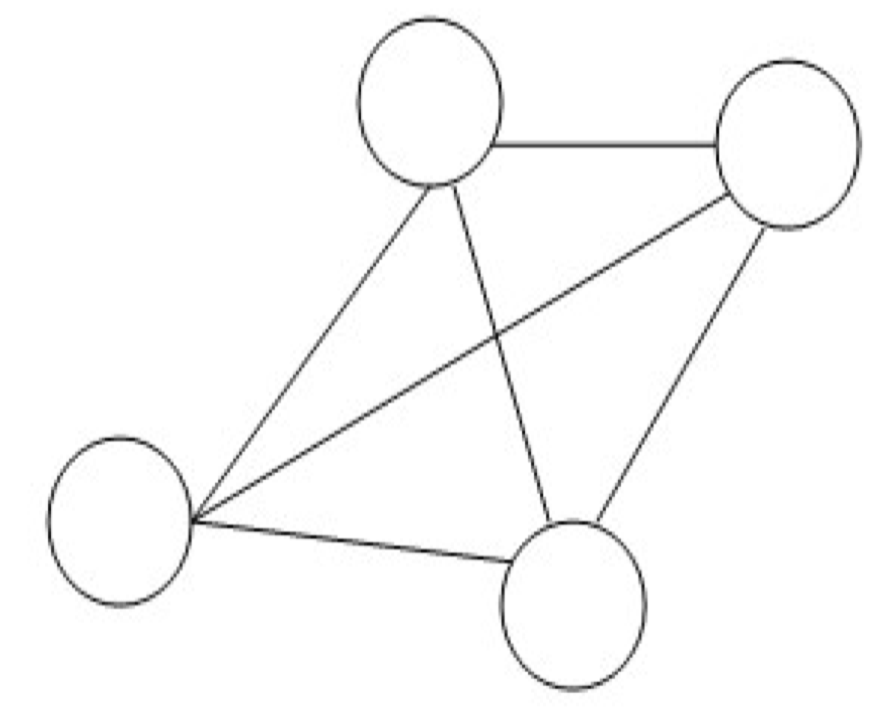
Open System Interconnection (OSI) Model
- Open System Interconnection (OSI) Model has seven layers.
- Physical Layer
- Data Link Layer
- Network Layer
- Transport Layer
- Session Layer
- Presentation Layer
- Application Layer
